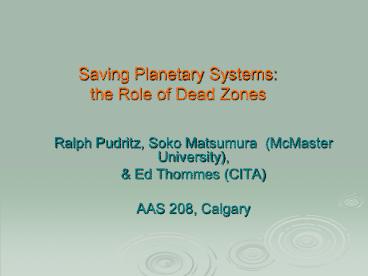Saving Planetary Systems: the Role of Dead Zones - PowerPoint PPT Presentation
Title:
Saving Planetary Systems: the Role of Dead Zones
Description:
Migration occurs by tidal interaction between planet and disk: ... Migration of a Jovian planet over 10 Myr. Note extent of gap opened by planet once inside dead zone. ... – PowerPoint PPT presentation
Number of Views:18
Avg rating:3.0/5.0
Title: Saving Planetary Systems: the Role of Dead Zones
1
Saving Planetary Systemsthe Role of Dead Zones
- Ralph Pudritz, Soko Matsumura (McMaster
University), - Ed Thommes (CITA)
- AAS 208, Calgary
2
- Migration can acconunt for orbits of massive
extrasolar planets - all within 5 AU
- Migration occurs by tidal interaction between
planet and disk - Type I migration without gap opening
- planet swallowed within 1 Myr.
- Type II migration after gap opening
- planet locked to disk and
migrates - at rate dictated by inner disk
again lost quickly - Why do planetary systems survive it?
- Absence of disk turbulence in dead zone in
central disk significantly slows planetary
migration (Matsumura, Pudritz, Thommes 2006
MPT06). Can even reverse it.
3
Dead Zone (Gammie, 1998) - Magnetic turbulence
is inactive in poorly ionized regions of the
disk so the disks viscosity is very low
there. - The DZ stretches out to about 13
Astronomical Units (1AU Earth-Sun
difference). Eg. Matsumura Pudritz 2006
(MNRAS)
Ionization X-rays from star cosmic
rays radioactive elements heating
from central star
4
Gap opens in a disk when Tidal Torque
Viscous Torque Level of magnetic turbulence
responsible for the viscosity of the gas
Protoplanet
Tidal Torque
Disk
Viscous Torque
Disk
5
Jupiter
Uranus or Neptune
Earth
6
1. eg. Type I migration (before gap-opening)
? 10 MEarth (lt MUranus)
Dead Zone
Star
Protoplanet
Numerical Technique We use a hybrid numerical
code combining N-body symplectic integrator SYMBA
(Duncan et al 1998) with evolution equation for
gas (Thommes 2005) - Allows us to follow
evolution of planet and disk for disk lifetime 3
10 Million years.
7
?10-2
?10-2
?10-5
8
If planet forms within the DZhalt migration of
terrestrial planets by opening a gap in the DZ
10 M_E planet started in dead zone Left 2
million yrs Viscosity
9
?10-3
?10-3
?10-5
10
- Migration of a Jovian planet over 10 Myr.
- Note extent of gap opened by planet once inside
dead zone. - Planet started at 20 AU settles into orbit at 4AU
after 10 Myr
11
- 10 ME opens gap at 3.5 AU in dead zone
- Also
- 1 ME opens gap near 0.1 AU
12
Percentage of planets that migrate and stop
within 5 AU
- Assume uniform distribution of disks with
temperatures (1AU) between 150 and 450 K and
lifetimes between 1 10 Million yrs - Observe 5-20 of stars with planets in this
regime - arises if disk viscosity lt 0.0001
Percent of planetary systems with planets
migrating inside 5AU
13
Summary
- Earth mass planets, that start migration outside
of DZ, are reflected to larger radii - Earth mass planets that are formed inside DZ halt
migration because they can open a gap in the disk
(eg. Earth mass at around 0.1 AU). - Massive planets open gaps, but their Type II
migration very slow in low viscosity DZ - If viscosity parameter is lt 0.0001, can account
for observed frequency of 5-20 of stellar
systems with planets inside 5AU

